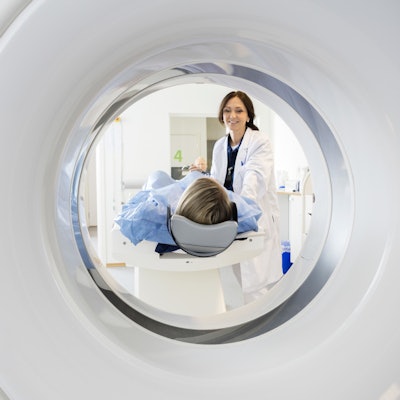
Central themes at ECR 2023 look set to be efficiency gains and workforce challenges, particularly radiologist burnout, skills shortages, and sustainability.
Price factors will also be dominant, as most vendors are shifting their focus to return on investment and the need to make systems more cost-effective. Increased vendor/personnel involvement from Asia Pacific is also anticipated at ECR 2023.
In this article, we assess the state of play in Europe ahead of the congress and provide a summary of what to expect in a range of modalities.
CT trends -- By Matthew Watson
 Matthew Watson.
Matthew Watson.Recent advances in CT technology are already exerting a transformative influence on the market, with the growing clinical viability of Photon-counting CT (PCCT) being perhaps the most notable. In this respect, ECR 2023 will serve as an opportunity for vendors with FDA-cleared and PCCT systems to enthuse attendees with burgeoning evidence of the technology's clinical performance. For vendors still in the developmental phase, or with installations of prototypes, ECR presents an opportunity to reveal their progress where the announcement be public or exclusive. Yet, while PCCT's capabilities continue to impress, the often prohibitively high price point and overall cost of ownership may still dampen otherwise palpable excitement. This should provide considerable room for interest in more affordable and more established spectral CT systems, which continue to be flagship systems for leading CT vendors.
As with RSNA 2022, cutting-edge AI software is also likely to feature prominently at this year's ECR exhibition: enduring shortfalls in the supply of qualified staff and high rates of burnout in radiology departments make enhancing workflow efficiency a continued priority. AI-based image reconstruction remains a fundamental theme for this modality. Demonstrations of the latest approved deep learning algorithms are expected to feature noise reduction and higher resolution whilst offering a reduced dosage and image reconstruction time.
Finally, sustainability is expected to play a central role as part of wider sustainable radiology initiatives, to decarbonize healthcare and ensure that healthcare providers benefit from long-term value of their investments.
MRI trends -- By Steve Holloway
 Steve Holloway.
Steve Holloway.Following a marked slow in demand during COVID, vendors are now experiencing a significant uptake of MRI as healthcare providers look to replace ageing fleets and better meet oversubscribed demand for MRI imaging. Efficiency, workflow and cost will remain front and centre of the agenda at ECR for MRI.
Buyers will be focusing mostly on the new generation of "workhorse" products with smarter workflow, patient positioning and "one-click" automation for protocol setup, supporting healthcare providers in driving faster patient throughput, fewer re-scans, and maximising the efficiency of over technologist staff resources. AI-based reconstruction will continue to support faster scan times and improved image quality in the newer generation of premium price bands. Recent examples of this new era of MRI include Philips Healthcare's SmartspeedMR and Siemens Healthineers' Deep Resolve offerings.
Lifetime value and sustainability of MRI equipment is also increasingly in focus, with system power consumption and services under scrutiny. "Lifetime" magnet retention programmes are now available, often as part of long-term managed service supply contracts, ensuring magnets and core components of systems can be retained and upgraded with new components and software, without requiring completely new systems.
AI trends -- By Sanjay Parekh
 Sanjay Parekh.
Sanjay Parekh.The prominence of AI at ECR has continued to grow over the past few years, and 2023 will prove no exception. Although RSNA remains the flagship show for most AI independent software vendors (ISVs), many will look to demonstrate their growth and traction, especially in Europe, at ECR.
One theme already emerging this year is market consolidation on the back of two significant acquisitions (Blackford Analysis, Caption Health). There will be excitement at the possibility of an exit among some AI ISVs. As some imaging IT and modality vendors look to expand their AI portfolios, AI ISVs must demonstrate a strong value proposition beyond point algorithms to secure a lucrative exit. However, for most ISVs, this is unlikely to materialise as they struggle to differentiate in a highly competitive field.
One group of ISVs looking to double down on their presence at ECR will be the Chinese vendors, especially given the challenges they faced during the COVID-19 pandemic. The number of Chinese ISVs receiving CE Mark for their solutions has grown steadily over the past few years, and now, they may look to capitalise on the opportunities, especially with expansive product portfolios covering multiple pathologies and body areas.
However, RSNA was only a few months ago, and for those AI ISVs that launched new products or announced new partnerships at the show, there are unlikely to be noteworthy announcements from these ISVs. However, for the ISVs that had a quieter RSNA or did not attend, ECR presents a ripe opportunity to capitalise on the growing post-COVID attendance keen to adopt AI within their imaging workflow.
X-ray trends -- By Bhvita Jani
 Bhvita Jani.
Bhvita Jani.Leading innovation within the x-ray market is expected to be centred around continued optimization of workflow efficiencies, driving faster patient throughput, and improving operational outcomes. Vendors will place a heightened focus on a combination of AI-powered camera-based workflows, smart protocoling, an expansion of AI-embedded solutions on the devices, and AI-empowered quality control of scans to help achieve this.
Hardware innovation is expected to, as seen in recent tradeshows, have a supreme focus on enhancing the experience of the technician or operator, with the betterment of ergonomic designs, such as collapsible columns and zero click examinations, to reduce repetitive strain and retain the workforce. Increased attendance from Asian vendors is also expected with the more favourable timing of the show this year and easing COVID regulations.
Ultrasound trends -- By Mustafa Hassan
 Mustafa Hassan.
Mustafa Hassan.ECR 2023 looks set to be busy for ultrasound vendors, with many raising a Stiegl in celebration of recent successes. On the back of its recent spin-off, GE HealthCare will be highlighting the impact its recent acquisition of Caption Health can have in improving patient outcomes. Elsewhere, Esaote and Siemens Healthineers will be showcasing the advanced features of their recently launched systems, the MyLab X90 and Juniper 2.5, and Mindray will look to showcase its smart hospital solutions, which include its TE Air Handheld and TEX 20 Series. Within Ultrasound AI, alongside the recently FDA-approved solution from DiA, the LVivo IQS, recent trade shows have seen increased attendance from new ultrasound AI vendors, and we expect this to continue at ECR 2023.
As with previous shows, we expect the focus for ultrasound vendors to be on efficiency solutions to address the patient backlog and make the work of radiologists easier. Vendors such as Esaote and Siemens have looked to address this with their new ultrasound systems. Additionally, features supporting ultrasound guidance, more efficient reporting and integration of ultrasound images and reports from a growing variety of applications and settings will be a key focus.



















